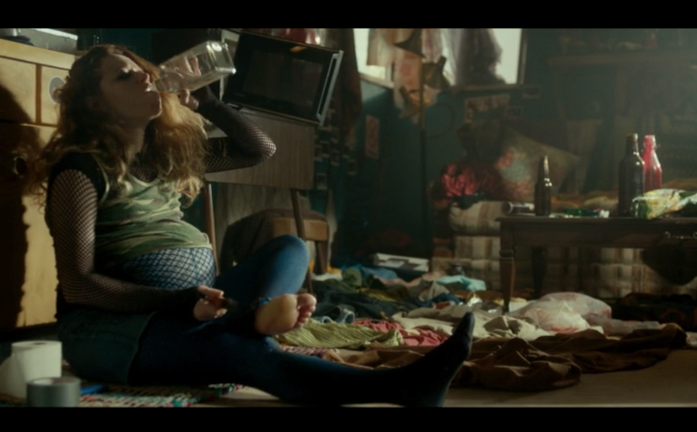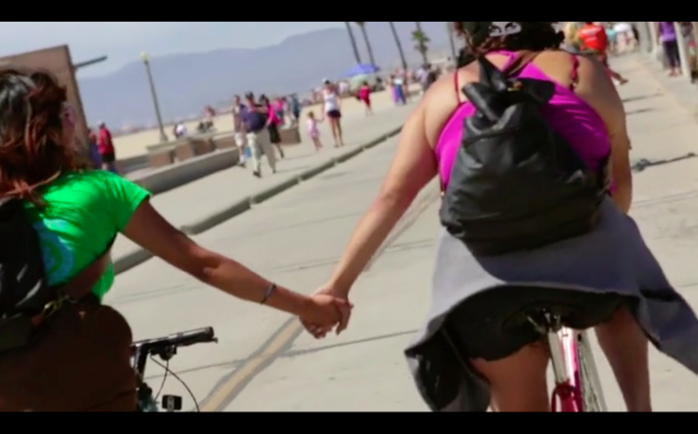The language of alien hosts and hospitality is not new to pro-life rhetoric; what does seem new, or new in this particular iteration, is the feminist reappropriation of these genital science fictions (i.e., “Pussy Bites Back”). In the wake of proposed defunding of Planned Parenthood and the rollback of pro-choice legislation, one of the more visible aspects of feminist mobilization is the metaphorical weaponization of the genitalia in question. See, for instance, the waves of pink pussy hats at the Women’s March in January or, in a more literal vein, the prevalence of anatomical signage and full-body vagina costumes. Of course, the rise of genitalia memorabilia offers a retort to President Trump’s suggestion for courtship via sexual assault, but it also signals an oppositional stance toward the antifeminist drift of the Trump administration more generally.
This anatomical tendency has been roundly criticized for equating feminism with the biological essentialism of cis-women. However, what Briallen Hopper has aptly called the “pussy hat controversy” is more complicated than essentialism or not-essentialism, vaginas or not, though the debates do skim over well-trod Second Wave territory. In some cases, the necessary argument for an intersectional feminism has taken on a strangely puritanical cast, one that, in the midst of trouncing biological normativity, also associates vagina-talk with the vulgar, the classless, the uneducated, the immature, or the merely gross. This distaste is uncomfortably close to reactions on the alt-right, which temper their repulsion with important historical lessons: “Perhaps someone should have explained to them that a significant aspect of the original feminist movement was to stop the sexual objectification of women,” writes Dawn Perlmutter, in “‘Pussy’ Symbolism and the Masked Hatred of the Women’s March,” an article from the pro-Trump Frontpage Mag that keeps “pussy” safely ensconced in quotation marks throughout its duration.
Presented with this newly weaponized gender essentialism on the center-left, one hasty (though perhaps satisfying) takedown threatens to reproduce this genteel distaste, forbidding all mention of vaginas entirely. But it seems hardly useful to retreat to a faux-Victorian avoidance of biology, so that the feminized body and its reproduction are unspeakable, better left to obscure formulations. (“You could see there was blood coming out of her eyes, blood coming out of her wherever.”) In the necessary turn toward intersectionality, I don’t want to erase lived forms of bodily vulnerability. An uneven distribution of sexual violence is historically skewed toward persons with vaginas, but it is also skewed toward women without them, to trans persons more generally, and to persons of color across gendered forms of embodiment. At this juncture, it seems more promising to open up the biological area, to reconsider feminist contestation amid a spectrum of organs and bodies, rather than as equivalent to this or that genital configuration.
For these reasons, I take Representative Humphrey’s remarks as an occasion to revisit the vexed intersections between biological gender and reproductive justice in one of the most canonical sites of feminist film theory, Ridley Scott’s Alien (1979), and, much more recently, what could be considered a loving remake, Danny Perez’s exploitation-horror movie, Antibirth (2016). In the 1980s, feminist film critics seized upon Alien’s depiction of the alien birth, biting its way out of the male body, as a canny depiction of a generalized male terror of female reproduction and feminization more generally. In Antibirth, Perez ups the gross-out factor. After the resplendently cranky Lou (Natasha Lyonne) is impregnated with an alien fetus, her body turns on her: teeth loosen and must be pulled out; neck skin peels off in a sheet; boils erupt on the bottoms of her feet. The gore is meta-gross, meta-Alien, and mostly funny, as the perpetually stoned Lou chain-smokes and drops acid throughout what appears to be a weeklong third trimester. Lyonne’s charisma drives the movie, in that she maintains a characteristically wry fed-upness throughout, rather than despair over the military industrial invasion of her body. Her face is genius — an artist’s palette of what the fuck in all its nuanced variations.
Antibirth is ripe for biopolitical allegory, a psychedelic mash-up of Fargo and body horror, filmed in rural Michigan. Lou blacks out at a warehouse party, then finds herself hugely pregnant. Flashback hallucinations are the site of the movie’s most psychedelic fever dreams: we pass between warehouse and a kiddie birthday party at Funzone, all balloons and birthday cakes. Lou wakes up tied to an exam table, feet in the stirrups. Candy-colored Chewbaccas writhe suggestively, then stroke her face through a forcible vaginal exam.
In The New York Times, Ken Jaworowski complained that watching the entirely of Antibirth is a traumatic experience, in which viewers emerge like “battle-scarred veterans of some 95-minute war.” He notes in particular what I will call the foot boil scene, an extended sequence in which the hugely pregnant Lou, well into half a bottle of vodka, uses a knife to lance that neon boil. Perez offers us a close-up of the medical procedure, which produces an outburst of orange goo. Well, it is a psychedelic body horror movie, what did you expect? What makes the film particularly canny is the way its remaking of Alien also serves as a forecast, in day-glo ooze, for a new era. What is scary is not so much the campy gore in question, but the military industrial invasion of the female body and the total lack of medical options available to the rural poor, all of which might leave a pregnant woman to administer her own medical care while breached on her trailer’s kitchen floor. The horror of Antibirth is its latent realism, leading up to an adult-sized alien birth, all gore and inverse vagina dentata. It’s a grotesque end indeed, long in the making. Lou is, after all, an ideal host: “Years of abuse have provided your womb with the perfect level of toxins necessary for this conception.”


¤
A different take on the intersection between biology and reproductive justice can be found in a documentary that appeared in film festivals this fall, but will premiere March 27 on PBS. Co-directed by Joanna Sokolowski and Kate Trumbull-LaValle, Ovarian Psycos chronicles a bicycle brigade for black and brown women, women-identifying persons, and gender nonconforming persons based out of Eastside Los Angeles and Boyle Heights. Founder Xela de la X describes the Ovas as “a refuge for the runaway, for the throwaway.” “We’re just that safe space for each other, to bring comfort, to bring a sense of family,” she says.
There are many such definitions, as though the Ovas are perpetually taking the temperature of the group across different iterations, different actions. “It’s for the uneducated woman; it’s for the knuckle-headed girls; it’s for the punk rockers, for the cholas, for, fuck, the sisters in the neighborhood,” says Joss the Boss, in a later interview. As a whole, the documentary is talky, major and minor characters perpetually chiming in. It tracks the beginnings of the Ovas as an autonomous group, from the first handful of meetings to the present day. Some Ovas talk about fear: “It was women not being scared of riding our bicycles or just claiming space in very dangerous zones.” Andi Xoch remembers the first couple meetings: “We were just excited to be hanging out with other women. We could be leaders without being bossy bitches.” Says Xela, “It feels like damn, I’m supported, I got backup. You feel like you could win the war.”

Amid a mini-history of Chicanx activism in Los Angeles, members explain why their group has chosen to organize along the lines of race and gender. Claudia explains:
Historically, brown women, you know, if they were working with white women on women’s issues, they were seen as betraying la Raza and our brown brothers. But then when we step into that space and try to work on issues of oppression based on race, that space is still very patriarchal, where women’s issues, you know, are put aside.
Joss is more succinct, but on point, in answering the question, “Why is it okay for women to do this and not for men?” Answer: “What the fuck, everything that you guys do is for men.”
A montage sequence of anonymous internet commentary gives us a sense of the resultant trolling: “A bunch of fatties.” “Grow the fuck up. Not everything with a dick is out to get you.” “Image whoring sexists on wheels.” Later, a bike shop bro opines, “There are probably people that could better handle the women’s issue discussion than the Ovarians […] the Chicano movement was a legitimate push for civil rights, but getting together and riding bikes? I don’t really know if that counts.”
As scholar Maylei Blackwell notes, the Ovas follow a long tradition of women of color organizing, one that links gender-based violence inside the home and outside of it. Noting the fallopian tubes on the masks that the Ovas wear, Blackwell praises this gesture as a co-optation of punk rock, riot grrrl, and gang cultures: “What women are shamed by, or what they are the victims of violence over, they claim it as their own and put it up front.”

The Ovas fallopian masks and uterine merch are undeniably biological, but they make up a strategic essentialism — essentialism as a tactic for survival but not a necessary prerequisite for communality. The documentary is dedicated to “the 1 in 3 women who will experience sexual or physical violence in their lifetime.” Between rides and interviews, the movie is punctuated by local news footage: the high schooler murdered by her boyfriend; another women’s body dredged from the lake; a family’s plea for their missing daughter. But there are also multi-generational histories of non-fatal domestic violence. Founder Xela obliquely narrates what, as a child, she did not have the language to tell her mother, then what her mother refused to believe. When Xela is talking and trying not to cry, she tends to swat at the air, as though shooing a fly. “I kinda see myself as a war vet,” she says, half-grinning, mid-swat. “I’m kind of fine with my amputated situation, right, but I feel that I have an obligation to the next generation, and for my daughter.”
By moving between different forms of gender-based violence, in the home and outside of it, Ovarian Psycos makes it clear that biological likeness might yield similar forms of bodily vulnerability, but does not necessarily make for solidarity. Xela remembers her own mother’s expectation that they would understand each other better when Xela herself had a child. At the hospital, post-labor, Xela recalls: “I just went through 16 hours of straight pain, like this labor, and they sewed me up for this child that I am now 100 percent responsible for.” She trails off. “I looked her in the eyes and said, ‘No, mom, I understand you even less.’”
Both Ovarian Psycos and Antibirth take up the biology of the feminized body, but anatomy doesn’t determine their politics. At the same time, bodies aren’t beside the point, so easily shuttled aside. Much of Ovarian Psycos chronicles the forms of affiliation rendered through the day-to-day life of community organizing: meeting procedures, whiteboard agendas, event committees, phone trees, wheat paste posters, traffic training, and so on.
Toward the end of the movie, Xela takes a step back from organizing, to spend more time with her daughter. To the directors’ credit, they do not show the exit of a charismatic leader as tragedy or the end of the group. After a three-month absence, Xela shows up at the demo, but leaves early, before the nighttime ride starts up, to go to her daughter’s birthday party. We see the party, then the last montage sequence starts loud, a dozen or so riders in formation, just turning the corner. Shot from above and at street level, the Ovas are masked-up in fallopian-tube gear, off-screen sound system blaring.
Critics have rightly praised these ensemble sequences, which occur with some regularity, across a succession of actions. But the scene that sticks with me happens before the mass ride, during the last demo, when Xela peels off early. It’s not a highpoint or low in the documentary’s narrative arc. This is a moment in a different kind of story, so often made illegible by the codes of movements past, in terms of what counts and what doesn’t. It’s the lack of tragedy that is important: not the departure of a leader, but the continuation of the leaderless anyways. Full stop. Later we’ll see the group shot with the credits, the screen all lens flares and raised fists. Shot in glare of midafternoon, this earlier scene is not particularly composed, not meant as a beginning or end of anything. It’s just Xela from behind, as she walks toward a street filled with cars and buses, the M30 slowing down. Before she gets on or looks back, the camera cuts away.
¤
From the late 1970s to the early 1990s, what became known as the feminist “sex wars” were primarily focused on pornography alongside a number of associated categories: sex work, sadomasochism, polyamory, butch-femme, women-born-women. As many have noted, race, respectability, and class played a key role in these debates, making the binary axis — sex-positive, sex-negative — fuzzier than retrospective accounts might like to suggest. By drawing a line between the feminist “sex wars” of yore and the “pussy hat controversy” today, I do not mean to suggest that these public debates are merely circular, rehashing the same old thing in different clothes. Rather, I invoke the word “war” to indicate something that might be won, but then must be won again, and again. This is not a tired repetition of what has already been settled, but a necessary reanimation, sometimes alien-themed or knitted, always problematic. It is necessary to keep reanimating these wars, to think through the histories of violence and gender across genital configurations and organizing strategies, through one feminist wave to the next, because gendered bodies are not something that can be settled or go away.
It is not so surprising, then, that so many feminist films today are reanimating the terms of the Second Wave. If Antibirth is an Alien remake, Ovarian Psycos offers a nod to another cult classic, Born in Flames (1983). Directed by Lizzie Borden, Born in Flames is dystopic science fiction staged as a faux-documentary. It takes place in an imagined future after the revolution, at a moment when gender and racial inequality nevertheless persist. The bike scene is likely the most famous part, often excerpted as a direct action how-to. Shot from above and at street-level, a fleet of women on bicycles appear from nowhere and glide down a deserted New York street, whistles blowing, to interrupt a sexual assault in progress. A newscaster provides the voiceover: “Police have been puzzled this week by what they describe as well-organized bands of 15-20 women on bicycles attacking men on the street.” The vigilantes in question are not, in fact, all gender-normative women, though almost everyone wears short-shorts. True to period style, the music is kicky ’80s funk, played over a crane shot of bikes, coasting one after another. They circle the median a few times, then leave the scene of the crime. During the zoom-out, we can hear the whistles shriek for a few extra beats, well after the bikes have disappeared into traffic, on their way to somewhere else.

¤
Jill Richards is an assistant professor in the English Department at Yale University.
LARB Contributor
LARB Staff Recommendations
The Fall of Feminism: Jessa Crispin’s “Why I Am Not A Feminist”
Maria Bustillos reviews Jessa Crispin’s “Why I Am Not A Feminist: A Feminist Manifesto.”
Waveforms and the Women’s March
Briallen Hopper on what we can learn from the Women's March.
Did you know LARB is a reader-supported nonprofit?
LARB publishes daily without a paywall as part of our mission to make rigorous, incisive, and engaging writing on every aspect of literature, culture, and the arts freely accessible to the public. Help us continue this work with your tax-deductible donation today!
:quality(75)/https%3A%2F%2Fdev.lareviewofbooks.org%2Fwp-content%2Fuploads%2F2017%2F03%2FRichardsAntibirth.png)